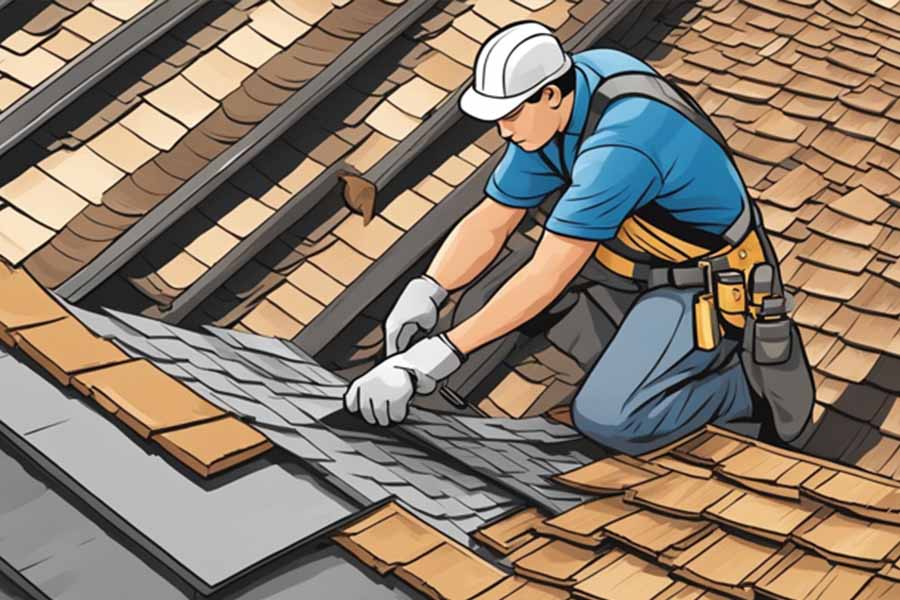Proper roof replacement is a crucial aspect of maintaining the structural integrity of a building. However, it is important to understand that the process of roof replacement takes time. Many factors can affect the length of time it takes to complete a roof replacement, including the size of the roof, the type of materials used, and the weather conditions.
One reason why proper roof replacement takes time is because of the preparation involved. Before any work can begin, the old roof must be removed, and the underlying structure must be inspected for any damage. This process can take several days, depending on the size of the roof and the complexity of the structure. Once the old roof is removed, the new roof must be carefully installed to ensure that it is structurally sound and watertight. This process can also take several days, depending on the materials used and the size of the roof.
Another reason why proper roof replacement takes time is because of the importance of quality workmanship. A poorly installed roof can lead to leaks, structural damage, and other costly problems down the line. To ensure that the new roof is installed correctly, it is essential to work with experienced and skilled professionals who understand the nuances of different roofing systems and materials. While this may add to the overall time it takes to complete a roof replacement, it is a necessary step to ensure that the new roof will last for many years to come.
Assessing the Current Roof Condition
Initial Inspection
Before a roof replacement project can begin, it is crucial to assess the current condition of the roof. This initial inspection involves a thorough examination of the roof to identify any damage or wear that may have occurred over time.
During the inspection, the roofing contractor will look for signs of damage such as cracks, leaks, and missing or damaged shingles. They will also inspect the roof’s flashing, gutters, and downspouts to ensure that they are functioning properly.
In addition to visual inspection, the contractor may also use specialized tools such as moisture meters to detect any areas of the roof that may have water damage. This comprehensive inspection helps to ensure that all areas of the roof are thoroughly assessed before any work begins.
Identifying Damage and Wear
Once the initial inspection is complete, the contractor will identify any areas of the roof that require repair or replacement. This may include damaged or missing shingles, cracked flashing, or worn-out gutters.
It is important to address these issues before beginning the replacement process to ensure that the new roof is installed on a solid foundation. Neglecting to address these issues can result in further damage to the roof and potentially compromise the integrity of the new roof.
In conclusion, assessing the current roof condition is a critical step in the roof replacement process. By conducting a thorough inspection and identifying any areas of damage or wear, the contractor can ensure that the new roof is installed on a solid foundation and will provide long-lasting protection for the home.
Planning and Design
Selecting Materials
When it comes to roof replacement, selecting the right materials is crucial. The materials used will determine the longevity, durability, and overall appearance of the new roof. A professional roofing contractor will work with the homeowner to select the best materials for their specific needs and budget.
There are a variety of roofing materials available, including asphalt shingles, metal roofing, tile roofing, and more. Each material has its own advantages and disadvantages, so it’s important to carefully consider all options before making a decision. Some factors to consider include the climate, the style of the home, and the homeowner’s personal preferences.
Scheduling and Timelines
Proper planning and scheduling are essential for a successful roof replacement project. A professional roofing contractor will work with the homeowner to create a timeline that accommodates their schedule and minimizes disruption to their daily routine.
The timeline for a roof replacement project will depend on a variety of factors, including the size of the roof, the materials used, and the weather conditions. It’s important to allow for extra time in case of unexpected delays or complications.
During the planning and design phase, the roofing contractor will also create a detailed plan for the installation process. This plan will include information about the removal of the old roof, the installation of the new roof, and any necessary repairs or modifications to the roof structure.
Overall, proper planning and design are essential for a successful roof replacement project. By working with a professional roofing contractor and carefully selecting materials and scheduling, homeowners can ensure that their new roof will be both beautiful and long-lasting.
Preparation and Safety Measures
Site Preparation
Before beginning any roof replacement project, it is essential to ensure that the site is properly prepared. This includes removing any debris or loose materials from the roof, as well as securing any loose shingles or tiles. Additionally, it is important to protect any surrounding landscaping or structures from potential damage during the replacement process.
To facilitate the replacement process, contractors may also need to bring in specialized equipment, such as cranes or scaffolding. This equipment must be properly installed and secured to ensure worker safety and prevent damage to the surrounding area.
Worker Safety Protocols
Proper safety protocols are crucial during any roof replacement project. Workers must be equipped with the necessary safety gear, including hard hats, safety glasses, and harnesses. Additionally, workers must be trained on how to properly use any equipment or tools required for the project.
To prevent falls, scaffolding and other equipment must be properly secured and inspected regularly. Workers must also be trained on how to properly move around the roof, taking care to avoid any potential hazards.
In addition to these safety measures, it is important for contractors to have a plan in place in case of an emergency. This includes having a first aid kit on hand and having a clear plan for evacuating the site in case of severe weather or other unexpected events.
By taking the time to properly prepare the site and implement safety protocols, contractors can ensure that the roof replacement project is completed safely and efficiently.
The Replacement Process
Removal of Old Roofing
Proper roof replacement involves a meticulous process that ensures the new roof will last for years to come. The first step in the replacement process is to remove the old roofing. This is a critical step that must be done carefully to avoid damaging the underlying structure.
The roofing contractor will start by inspecting the old roof to determine the best way to remove it. They will then remove the shingles, underlayment, and any other roofing material. The old roofing material is carefully disposed of to avoid causing any damage to the environment.
Installation of New Roofing
Once the old roofing has been removed, the contractor will install the new roofing. This involves several steps, including installing new underlayment, flashing, and shingles. The contractor will also ensure that the roof is properly ventilated to prevent moisture buildup and extend the life of the new roof.
The installation process can take several days, depending on the size of the roof and the complexity of the job. The contractor will work carefully to ensure that the new roof is installed properly and meets all local building codes.
Proper roof replacement takes time, but it is worth the investment. By following a meticulous process that includes the careful removal of the old roofing and the proper installation of the new roofing, homeowners can ensure that their new roof will last for years to come.
Quality Assurance and Final Inspection
Once the roof replacement process is complete, a quality assurance and final inspection must be carried out to ensure that the new roof meets all the necessary standards. This process is crucial because it helps to identify any potential issues that may have been missed during the installation process.
During the quality assurance process, the contractor will inspect the roof to ensure that it has been installed correctly and that all the materials used are of high quality. This may involve checking the flashing, gutters, and other components to ensure that they are properly installed and functioning correctly.
Once the inspection is complete, the contractor will provide a report detailing any issues that were identified during the inspection. If any issues are found, they will need to be addressed before the project can be considered complete.
It is important to note that the quality assurance and final inspection process can take some time, but it is necessary to ensure that the new roof is of the highest quality and will provide the necessary protection for the building. By taking the time to carry out this process, property owners can have peace of mind knowing that their investment is protected and that their new roof will last for many years to come.





0 Comments